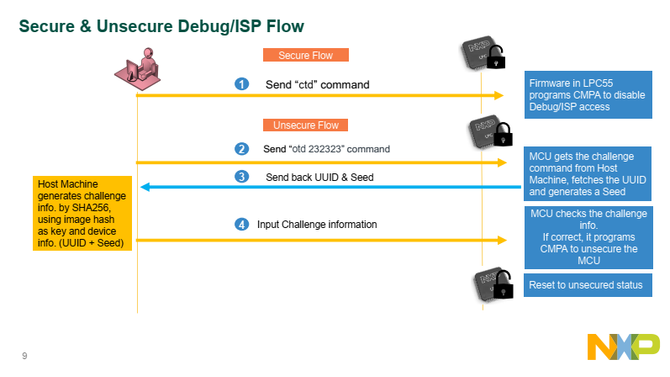- Forums
- Product Forums
- General Purpose MicrocontrollersGeneral Purpose Microcontrollers
- i.MX Forumsi.MX Forums
- QorIQ Processing PlatformsQorIQ Processing Platforms
- Identification and SecurityIdentification and Security
- Power ManagementPower Management
- Wireless ConnectivityWireless Connectivity
- RFID / NFCRFID / NFC
- Advanced AnalogAdvanced Analog
- MCX Microcontrollers
- S32G
- S32K
- S32V
- MPC5xxx
- Other NXP Products
- S12 / MagniV Microcontrollers
- Powertrain and Electrification Analog Drivers
- Sensors
- Vybrid Processors
- Digital Signal Controllers
- 8-bit Microcontrollers
- ColdFire/68K Microcontrollers and Processors
- PowerQUICC Processors
- OSBDM and TBDML
- S32M
- S32Z/E
-
- Solution Forums
- Software Forums
- MCUXpresso Software and ToolsMCUXpresso Software and Tools
- CodeWarriorCodeWarrior
- MQX Software SolutionsMQX Software Solutions
- Model-Based Design Toolbox (MBDT)Model-Based Design Toolbox (MBDT)
- FreeMASTER
- eIQ Machine Learning Software
- Embedded Software and Tools Clinic
- S32 SDK
- S32 Design Studio
- GUI Guider
- Zephyr Project
- Voice Technology
- Application Software Packs
- Secure Provisioning SDK (SPSDK)
- Processor Expert Software
- Generative AI & LLMs
-
- Topics
- Mobile Robotics - Drones and RoversMobile Robotics - Drones and Rovers
- NXP Training ContentNXP Training Content
- University ProgramsUniversity Programs
- Rapid IoT
- NXP Designs
- SafeAssure-Community
- OSS Security & Maintenance
- Using Our Community
-
- Cloud Lab Forums
-
- Knowledge Bases
- ARM Microcontrollers
- i.MX Processors
- Identification and Security
- Model-Based Design Toolbox (MBDT)
- QorIQ Processing Platforms
- S32 Automotive Processing Platform
- Wireless Connectivity
- CodeWarrior
- MCUXpresso Suite of Software and Tools
- MQX Software Solutions
- RFID / NFC
- Advanced Analog
-
- NXP Tech Blogs
- Home
- :
- Topics
- :
- NXP Designs Knowledge Base
- :
- LPC55 Debuging Ports Security Solution
LPC55 Debuging Ports Security Solution
- Subscribe to RSS Feed
- Mark as New
- Mark as Read
- Bookmark
- Subscribe
- Printer Friendly Page
- Report Inappropriate Content
LPC55 Debuging Ports Security Solution
LPC55 Debuging Ports Security Solution
Background:
➢ IP protection is important for most customers, Kinetis, LPC54 series and i.MX RT have necessary security features that help us to win customers and markets.
➢ LPC55 series is a new generation of IoT MCU which is used for consumer and industrial market. LPC55 non-S parts are adopted by most customers due to its low-cost and easy-to-use features, but its secure features are different with S parts and is significantly simplified.
➢ LPC55 is designed for secured IoT application, so it’s supposed to hide the SWD/ISP ports after development work is finished. If the SWD/ISP ports are secured, they couldn’t be used any more. While for LPC54 & Kinetis MCU, mass erase command can be used to recover the MCU after the MCU is secured.
➢ However, Customers need the feature to secure the debugging/ISP ports, but they also need to recover them in some cases:
- Reprogramming to update firmware
- Investigate and analyze failed parts returned from end market
- Rescue the MCU if it’s locked and stuck
➢ According to customers’ requirements, NXP support team raised the proposal to implement a solution which can be used to secure and recover the SWD/ISP ports with an IAP backdoor
method.
Solution:
By Operating PFR region, LPC55 could switch between secure and recovery mode.
- lpc5506_debug_isp_test_20220714: demonstrate how to operate this region to lock Debug Port then how to recovery it. The user interaction could be raised by UART or button;

2.hmac_test_20220714: demonstrate one full security flow,

➢ This is a complete solution to secure & recovery debugging/ISP ports on LPC55, and it uses
host machine challenge mechanism to implement security features:
▪ Challenge Host machine against unknown host probe;
▪ Generates dynamic seeds, so that the final encrypt information will be dynamically changed;
▪ The image hash value is device related, that avoids same encrypt info for different image/product;
➢ Customer also could clip the solution to simplify application complexity:
▪ Use UUID for device information only, no seed is needed;
▪ Host machine can use fixed keys instead of image hash values to do info encryption;
▪ Host machine can use UUID lookup table to find out verification key; Every device is programmed with dedicated verification key during production.
Demonstration:
The attached demos could run at LPC55S06 EVK, and could easily migrate to other LPC55 series.